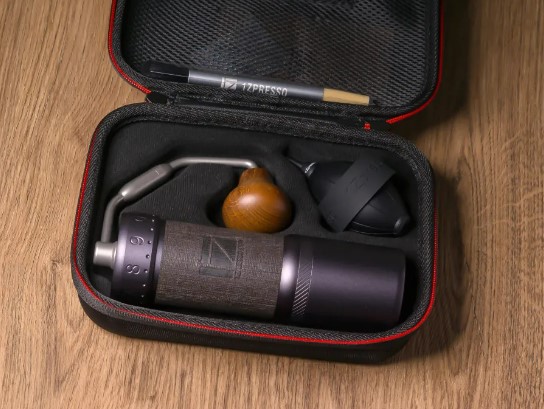Workmanship Meets Efficiency: Introducing 1Zpresso J-Max Coffee Mill
Workmanship Meets Efficiency: Introducing 1Zpresso J-Max Coffee Mill
Blog Article
Master the Art of Grinding Coffee Beans: A Guide to Coffee Grinders
For coffee lovers, the process of grinding coffee beans is even more than simply a routine task; it is an art type that can considerably influence the taste and quality of the final mixture. Coffee grinders play a crucial role in this fragile process, yet grasping their usage involves more than just pushing a button. Understanding the nuances of various mill types, picking the proper grind size, and using the right strategies are crucial steps in the direction of achieving that best cup of coffee. Nevertheless, the trip in the direction of ending up being a coffee grinding maestro doesn't end there. As we explore the intricacies of this craft, we will certainly discover upkeep secrets, repairing ideas, and extra, all aimed at boosting your coffee experience to brand-new elevations.
Kinds of Coffee Grinders
There are 3 primary kinds of coffee grinders frequently utilized by coffee lovers: blade grinders, burr mills, and hands-on mills. Blade mills are the a lot of standard type, using an easy blade to chop the coffee beans. While they are budget-friendly and very easy to use, they commonly lead to unequal coffee grounds as a result of inconsistent grinding. Burr mills, on the various other hand, provide more precision by squashing the beans in between a moving grinding wheel and a non-moving surface. This causes an uniform grind size, which is essential for a regular coffee taste. Burr grinders come in both flat and conical forms, each offering somewhat different grinding features.
Hands-on mills, as the name suggests, call for manual effort to grind the coffee beans. They are commonly preferred by those who take pleasure in the procedure of hand developing coffee or for those that value mobility. Hands-on mills can vary in layout, from straightforward handheld models to more complex kitchen counter variations. While they may need even more initiative, hands-on grinders provide control over the grinding procedure, permitting users to change the grind size to their preference. Each sort of coffee mill has its benefits and excellent usage instances, dealing with the diverse choices of coffee fanatics.

Picking the Right Work Dimension
With an understanding of the different types of coffee mills, the following crucial action in accomplishing the excellent cup of coffee is choosing the ideal work size. 1Zpresso J-Ultra The work size plays a significant role in determining the taste profile of your coffee (1Zpresso J-Max). Different brewing techniques need details work dimensions to enhance the extraction of tastes from the coffee grounds
For a coarse work, ideal for French press and chilly brew techniques, the coffee beans need to resemble breadcrumbs, supplying a robust and bold taste. Medium-coarse grinds, ideal for Chemex or Clever Dripper, have a structure similar to crude sand, supplying a well balanced preference.
Medium grinds, frequently utilized in drip coffee manufacturers, have a consistency resembling routine sand, resulting in an all-around flavor. Great grinds, ideal for espresso devices, are akin to salt, generating an abundant and intense preference. Ultimately, extra-fine grinds, utilized in Turkish coffee, are as great as powdered sugar and create a solid and potent mixture.
Grinding Techniques for Optimal Flavor
To remove the maximum possibility of taste from your coffee beans, grasping correct grinding techniques is crucial. Consistency is vital when it comes to grinding coffee beans for ideal taste. By paying interest to these grinding techniques, you can boost the taste profile of your coffee and take pleasure in a more enjoyable cup every time.
Maintenance and Cleaning Up Tips

Change any type of worn-out components quickly to preserve the top quality of your coffee grind. By adhering to these upkeep and cleansing ideas, you can guarantee that your coffee mill proceeds to provide tasty newly ground coffee for years to come.
Troubleshooting Common Mill Issues


Guaranteeing your coffee grinder works smoothly calls for proficient troubleshooting of usual issues that may emerge during its usage. One typical problem with coffee mills is inconsistent work dimension.
An additional constant problem is grinder blocking. This can occur when oils from the coffee beans develop and obstruct the grinder's chute. To fix this, disassemble the grinder and clean all parts extensively, paying unique interest to the chute and burrs. Furthermore, bear in mind overfilling the hopper to avoid blockages.
Lastly, if your mill is creating too much noise during operation, it could indicate a problem with the motor or inner parts. In such instances, it is a good idea to seek advice from the producer's instructions for fixing steps or seek specialist support to identify and rectify the problem quickly.
Verdict
To conclude, grasping the art of grinding coffee beans entails understanding the different kinds of coffee grinders, selecting the ideal grind dimension, using appropriate grinding strategies for ideal taste, and preserving and cleaning up the mill regularly. By adhering to these guidelines and fixing common mill concerns, coffee lovers can raise their coffee developing experience and enjoy a scrumptious cup of coffee every single time.
Report this page